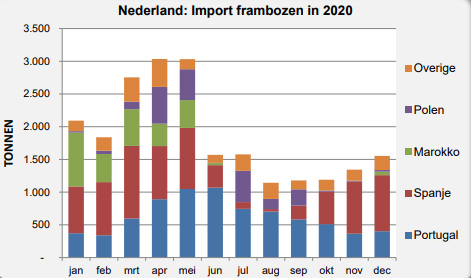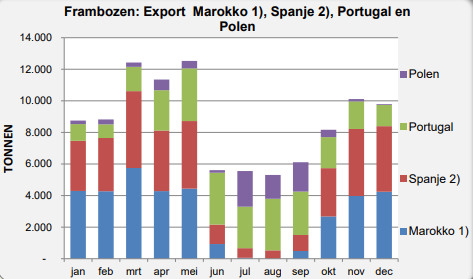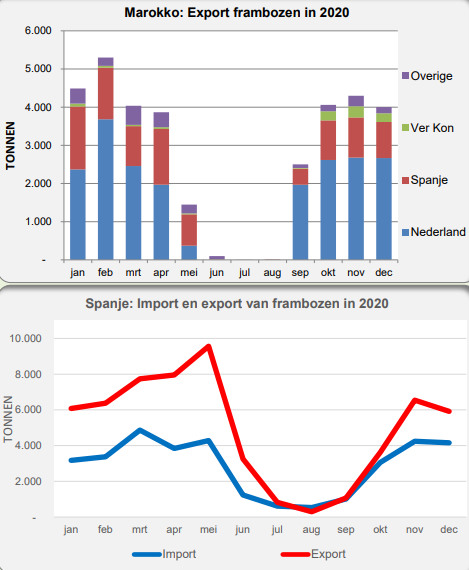Dutch consumers have grown to love blueberries. Now, raspberries and blackberries are gaining popularity. Compared to blueberries, raspberries and especially blackberries are a modest product. Raspberry production in the Netherlands is of moderate size. In 2020, less - 3,600 tons - was harvested than before. In previous years, it was 4,500 tons. Dutch commercial blackberry cultivation is even smaller.

Despite these small volumes, there are several initiatives to expand these products' cultivation. Those are in the Netherlands and, for example, Germany. The Dutch raspberry season has already been extended considerably. Those, and German raspberries, are available from May to October. In the Netherlands, there are some 30 hectares of covered raspberry farms. There is even small-scale experimentation with growing them under (translucent) solar panels.
Much processing, especially frozen
There are some important large-scale raspberry-growing countries. They are Russia, Mexico, Serbia, Morocco, the United States, Poland, Spain, Ukraine, Bosnia, Portugal, the United Kingdom, Chile, and Azerbaijan. Most raspberries grown in those countries are processed.
Serbia, Ukraine, and Bosnia, for instance, are major frozen raspberry suppliers. Mexico is, by far, the top fresh raspberry exporter. In 2020, that country exported more than 100,000 tons of these soft fruits to the United States. Mexico sends modest quantities of raspberries to other countries, including European ones, too.

Raspberries: Export Morocco 1), Spain 2), Portugal, and Poland.
Spain: a major exporter
With 60,000 to 70,000 tons, Spain is the world's second-largest raspberry exporter. That includes some re-exports of Moroccan products. Morocco follows, with 35,000 tons, and Portugal with 26,000 tons. Polish exports of (fresh) raspberries are declining. That amounted to about 8,500 tons last year.
Year-round availability
Raspberries are available year-round on the European market. Portugal and Spain export throughout the year. The Moroccan export season runs from September to April/May. And Polish raspberries are on global markets from April to September/October.
The EU27 countries import smaller quantities of raspberries too. Those come from Germany (7,600 tons; re-export of Polish product?) and Belgium (3,400 tons; also many re-exports). But also from the UK (2,400 tons), France (1,500 tons), and Serbia (1,300 tons). And Italy (740 tons), Ukraine (560 tons), Mexico (410 tons), and Austria (380 tons).

Top: Morocco: 2020 Raspberry exports. Bottom: Spain: Imports and exports of raspberries 2020.
Dutch imports growing
The Netherlands is importing more and more raspberries. Last year, that amounted to 22,000 tons. That is more than 20% more than the 18,400 tons the country imported in 2019. Belgium is also increasingly importing raspberries. In 2020, it was 9,100 tons. That is 30% more than the previous year.
The Netherlands, especially, re-exports many of these berries. Last year, Dutch raspberry exports totaled 18,600 tons. Of these, 460 tons were locally grown. In 2019, that was more than 650 tons. That is according to Fresh Produce Center and the Dutch Quality Control Bureau figures.
The Netherlands is a thoroughfare country for raspberries too
So, for raspberries, too, the Netherlands is an important thoroughfare country. In 2020, Portugal was the Netherlands' main raspberry supplier. The Netherlands imported 7,600 tons from that country. In 2019, that was 6,300 tons. In that year, Spain was still at the top of the list. However, Dutch raspberry imports from that country have fallen from 9,200 tons to 7,200 tons.
According to Eurostat, the Netherlands imported 2,700 tons of raspberries from Morocco last year. And from Poland, 2,200 tons. Of note is that, according to Moroccan statistics, 60% of exports are aimed at the Netherlands. In 2020, that amounted to 20,000 tons of 34,000 tons total exports. But Eurostat states that most Moroccan raspberries enter the EU via Spain.
Stable Belgian imports
Belgium's raspberry imports have remained fairly stable since 2018. It is always about 6,500 tons. Only in 2018 was it more, at 8,400 tons. According to Eurostat, most (via re-export) come from the Netherlands. Germany is a large raspberry import market. In 2019 and 2020, that country took about 40,000 tons. Morocco is the main supplier, with Spain close behind. Portugal is at number third, and Poland follows.
The United Kingdom imported somewhat fewer raspberries last year. It took 26,200 tons. In the record year of 2019, that was 27,900 tons. More than half usually come from Spain, which probably includes Moroccan re-exports. According to UK export statistics, the Netherlands is their second-largest raspberry supplier.
Click here for the factsheet (in Dutch)
For more information:
Jan Kees Boon
Fruit and Vegetable Facts
Email: [email protected]
Website: www.fruitandvegetablefacts.com
